HERE ARE PHOTOS of Saint Peter Church, which is adjacent to the Missouri State Capitol building in Jefferson City. Originally a part of the Archdiocese of Saint Louis and later the cathedral of the Diocese of Jefferson City, this parish church is located about 25 miles east of the geographic center of the state of Missouri in Cole County, and is about 127 highway miles west of downtown Saint Louis.
I took these photos in June of 2011.
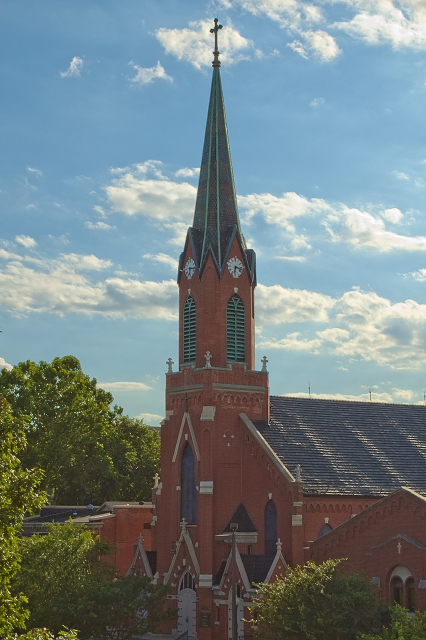
The exterior of the church as seen from the state capitol building.
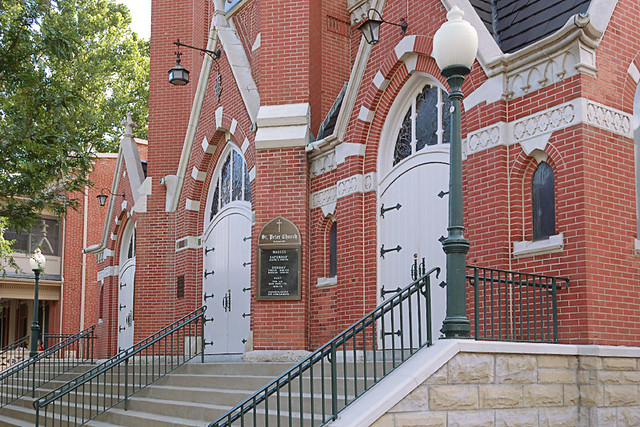
According to a history of the church:
The history of St. Peter Church and Catholicism in Jefferson City can be traced back to just ten years after the founding of the capital city in 1821. Fr. Felix L. Verreydt, S.J., came from the Indian Mission of Portage des Sioux, St. Charles County, Missouri, and celebrated the first recorded Mass in Jefferson City in 1831 in the home of Bernard Upschulte, then located on the corner of High and Mulberry Streets, now located behind the Cole County Historical Museum. In 1838, Fr. Ferdinand Helias, S.J., newly appointed pastor at Westphalia, Osage County, Missouri, at the request of the visiting Rt. Rev. Joseph Rosati, C.M., first bishop of St. Louis, organized the local Catholics into a community and celebrated Mass in private homes until a site could be selected for a church. (Interestingly enough those "private homes" were less than 10 in number as records show a total of nine Catholic families registered in 1838!) Fr. Helias was also the first priest to minister to the inmates of the state prison, located in Jefferson City. The original candlesticks and crucifix that he carried in his saddlebags throughout his ministry are on display in the St. Peter Parish Life Center.
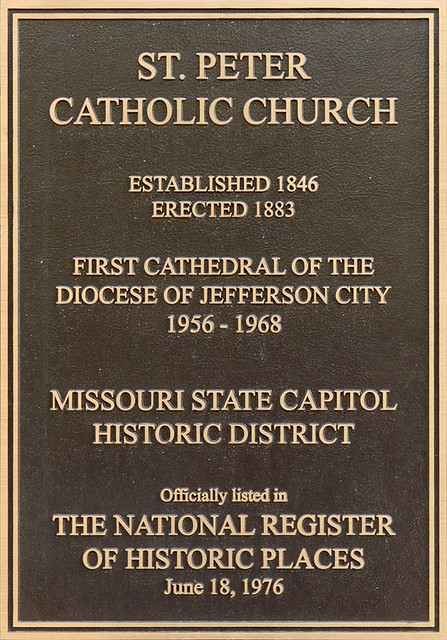
ST. PETER CATHOLIC CHURCH
ESTABLISHED 1846 ERECTED 1883
FIRST CATHEDRAL OF THE DIOCESE OF JEFFERSON CITY 1956-1968
MISSOURI STATE CAPITOL HISTORIC DISTRICT
Officially listed in THE NATIONAL REGISTER OF HISTORIC PLACES June 18, 1976
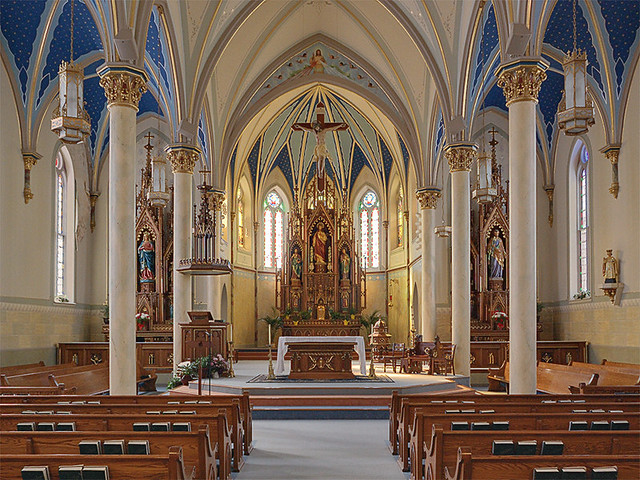
Continuing the history of the church:
The present church was designed by Adolph Druiding and constructed by Fred H. Binder with 800,000 bricks donated by G.H. Dulle. It was placed on the National Register of Historic Places on June 18, 1976. The church is pure gothic. It is 173 and one half feet in length. It is 60 feet in width. It has a seating capacity of 700. The clock tower, a city landmark, rises to a height of 170 feet. The tower contains four bells cast by the Struckstede Foundry with an aggregate weight of 8,000 pounds, purchased at a cost of $1,354 and dedicated to St. Peter (55 inches in diameter), St. Joseph (46 inches), The Sacred Heart of Jesus (34 inches), The Blessed Virgin Mary (28 inches).The architect of this church, Adolphus Druiding, also designed the Shrine of Saint Joseph, Saint John Nepomunk, and Saint Agatha churches in Saint Louis, as well as many others throughout the eastern United States.
It is impossible to separate our parish history from the history of Jefferson City and the city’s role as the seat of state government. The clock, installed in 1888, is of service to both church and state. It rings the hour for divine services and every four years the new governor of Missouri is sworn into office when C-sharp minor cords have struck noon. In 1911, during the fire at the State Capitol building, which sits literally across the street from our parish home, the Missouri State House of Representatives used St. Peter’s School library to conduct business for the remainder of that legislative session. Gov. Joseph P. Teasdale, 1977-81, was a member of St. Peter and attended noon Mass frequently.
The interior of the church retains the gothic motif. Two majestic tiers of fourteen pillars support the ceiling, dividing the church into three naves. The height of the center nave is 56 feet; the two side naves are 42 feet. Three gothic reredos attest to our history. They are carved of white walnut with rich gilt. The main, center reredos, which houses the tabernacle, is 49 feet high. It contains a center statue of the Sacred Heart of Jesus. The two lower niches contain statues of St. Peter, the first pope, with keys, and St. Paul, Apostle to the Gentiles, with sword. The side reredos are 24 feet in height. The shrine to the Blessed Mother contains statues of St. Agnes, patroness of virgins, with a lamb, and St. Rose of Lima with the Christ child, patroness of South America (a link which the Diocese of Jefferson City has enjoyed through our missionary work in Peru). On the opposite side is a statue of St. Joseph, accompanied by one of St. Aloysius Gonzaga, patron of youth, with crucifix, and another of St. Francis de Sales, patron of authors and the press, with a book.
The present church's service to Jefferson City began on Feb. 2, 1883, when Monsignor Hoog celebrated the first Mass. It was solemnly dedicated on Aug. 12, 1883, by the Rt. Rev. Patrick J. Ryan, Coadjutor Bishop of St. Louis.

The tabernacle sits upon the old high altar; here is the baptismal font.
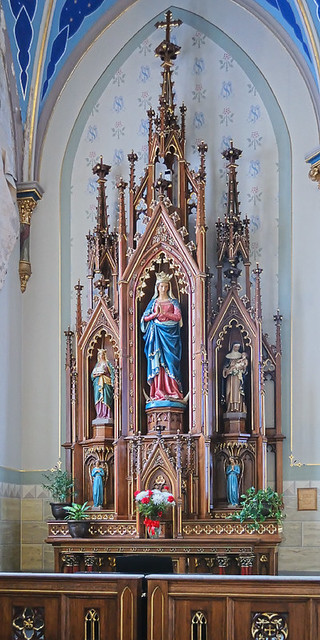
Altar of the Blessed Virgin Mary.
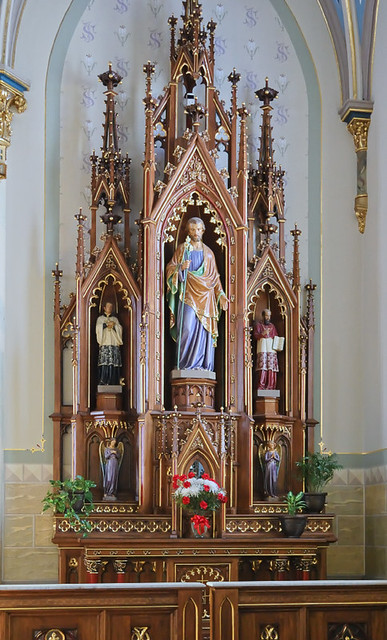
Altar of Saint Joseph.

A view looking back to the choir loft with organ pipes.

The ceiling has a representation of the starry heavens.
This church has been renovated many times. According to the history:
In 2002, the interior was again refinished. The work seeks to implement a guiding principle for renovating older churches. There is no substitute for an ecclesiology which is both ancient and modern in the fullest sense (Built of Living Stones USCCB, 2000). The values of beauty, mystery, and awe guided the work of the Liturgical Design Consultant, Mr. Tom Sater, and the Church Interior Committee, made up entirely of parishioners, in the most recent renovation of our Church. It was important that these concepts blend the gothic architecture and the guide the décor chosen for the Church. Much time was spent studying numerous photographs of the Church from various times in its history so that the artwork from these historic times could be incorporated into the present renovation.
In Western cultures, gothic is considered the most religious architectural style because of the ascendant structure, which draws one’s eyes toward heaven and encourages us to meditate on God and the things of God. This is expressed architecturally through the windows and pillars as well as through the colors that were chosen. Darker colors were selected for the ground level and gradually become lighter as it ascends towards the heavens. The colors chosen for the Church décor were determined by the colors in the stained glass windows and the outside bricks and stone.
The side naves’ celestial sky treatment with clouds and stars, harkens to the early Gothic desire to Embrace the Heavens. The center nave contains stenciling that reminds us of the five wounds of Christ. The red drop reminds us of the blood of Christ shed for us. It is surrounded by the nails of the crucifixion.
The three reredos, which in the past were known as the main and side altars, are also gothic in style and dominate the interior. When the reredos were removed for their restoration, two happy coincidences occurred. The original stain color of the reredos was discovered on the side panel of the St. Joseph reredos. This butternut color was restored to the reredos. Also, when the reredos were removed, the original stenciling on the walls behind the reredos was discovered. The designs consist of St. Mary’s monogram, S/M with her symbol, the rose, and St. Joseph’s monogram, S/J, with the lily. This is the original stenciling from 1883, and was restored to the area behind the reredos.
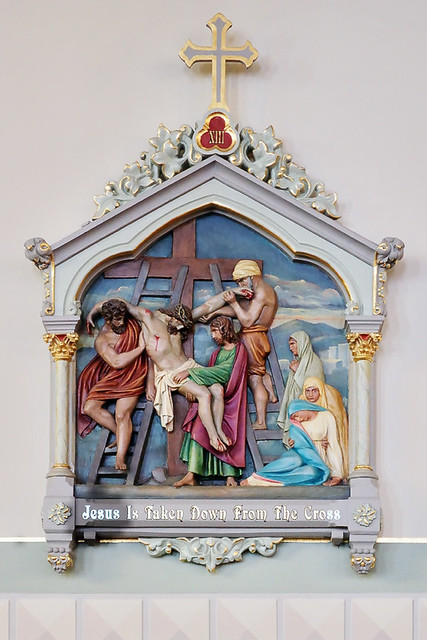
XIIIth station of the cross: Jesus is taken down from the cross. “Consider how, after Our Lord had died, He was taken down from the cross by two of His disciples, Joseph and Nicodemus, and placed in the arms of His afflicted Mother. She received Him with unutterable tenderness and pressed Him close to her bosom.”
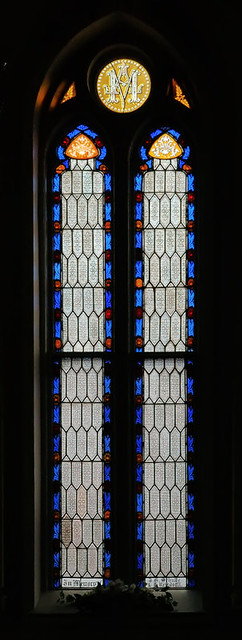
The windows in the nave of the church are largely non-representational.
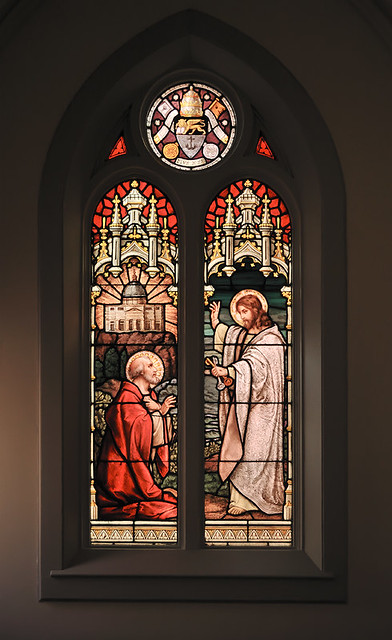
In the narthex, Saint Peter receives the keys of the Kingdom of Heaven (Matthew 16:19).
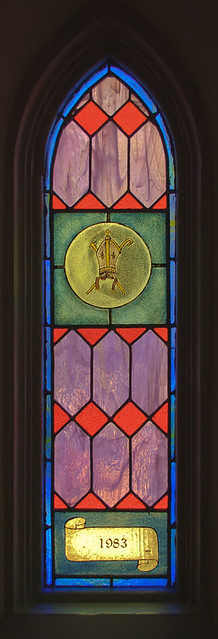
A stained glass window of a bishop’s mitre, 1983.
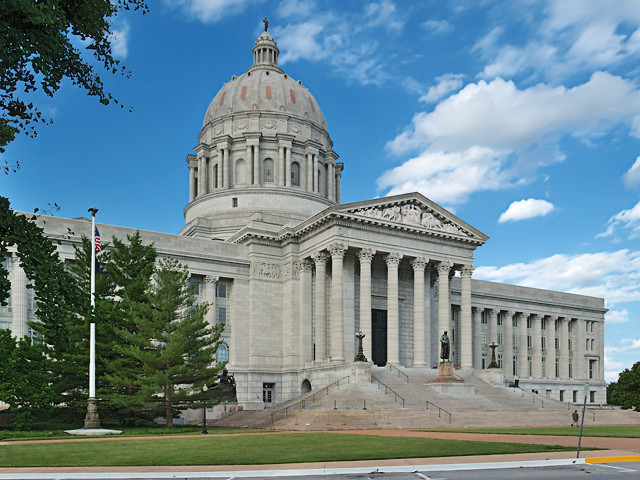
A view of the Missouri State Capitol building, taken near the church.
Address:
216 Broadway
Jefferson City, Missouri


Wow, definitely "draws one’s eyes toward heaven and encourages us to meditate on God and the things of God." This is a most beautiful and majestic Church! Thanks, we need beauty like this in our lives.
ReplyDeleteThese are beautiful photographs of a magnificent church. I grew up in Missouri and now regret never having visited the capital city. Your extraordinary work previously inspired my pilgrimage to St. Louis and Starkenburg, and now I'll have to visit Jefferson City as well! I'm profoundly grateful to you for sharing your artistry and insight in the service of Our Lord.
ReplyDeleteWow! absolutely beautiful! I especially love the mural of the Divine Mercy above the altar!
ReplyDeleteThank you for the great pictures. That spire had always reminded me of St. Agatha's. Now I know why!
ReplyDeleteIn a thrift shop in Hayesville, NC this week I came across a Parish Prayer Book ("Adoremus") from your parish dated 1940. Imprimatur Joannes J. Glennon. I thought you might like to have it for your archives. I am Rosemary Braun on Facebook from Port Jefferson (irony!), New York. Please message me if you are interested or call me at 631 828 6890.
ReplyDelete